AUCTORES
Globalize your Research
Research Article | DOI: https://doi.org/10.31579/2690-4861/541
College of Chemistry and Material Science, Shandong Agricultural University, Taian 271018, P. R. China.
*Corresponding Author: Nan Lu, College of Chemistry and Material Science, Shandong Agricultural University, Taian 271018, P. R. China.
Citation: Nan Lu and Chengxia Miao, (2024), Theoretical Investigation on Intramolecular Friedel-Crafts Alkylation Of 2,2′-Disubstituted 1,3-Indandione Delivering Axially Chiral Biaryls Catalyzed by Chiral Phosphoric Acid, International Journal of Clinical Case Reports and Reviews, 19(2); DOI:10.31579/2690-4861/541
Copyright: © 2024, Nan Lu. This is an open-access article distributed under the terms of the Creative Commons Attribution License, which permits unrestricted use, distribution, and reproduction in any medium, provided the original author and source are credited.
Received: 16 September 2024 | Accepted: 30 September 2024 | Published: 07 October 2024
Keywords: central-to-axial conversion; Friedel-Crafts alkylation; rearrangement; aromatization; chiral phosphoric acid
Our Density Functional Theory (DFT) calculations provide the first theoretical investigation on CPA-catalyzed intramolecular Friedel-Crafts alkylation of 1,3-indandione. The reaction is initiated by bis-coordination of CPA with carbonyl and phenol of indandione. The promotion of CPA lies in H-bridge and steric effect from big silyl substituents confirming less-hindered Re-face more favorable than more-shielded Si-face within central chiral alcohol. Next AlCl3-promoted process contains four steps. The dehydration gives positive carbocation, the rearrangement of which activates another carbonyl. The water reversely splits into hydrogen and hydroxyl to recover phenol. The naphthol is obtained from opening of five-membered ring. The central-to-axial chirality conversion is secured between methyl/phenol substituents and carboxylic moiety of axially chiral biaryls. The positive solvation effect is suggested by decreased absolute and activation energies in solution compared with in gas. These results are supported by Multiwfn analysis on FMO composition of specific TSs, and MBO value of vital bonding, breaking.
The structural core of axially chiral bi(hetero)aryl are identified with potential medicinal applications in pharmaceuticals and as natural products [1–3]. This brings various strategies to handling stereochemistry from drug regulatory agencies. The ability of natural receptors possess differential binding between atropisomers and require new techniques for atropselective synthesis of desired targets. The general approach frequently used in asymmetric synthesis for chiral ligands and catalysts has received much attention such as phosphoramidites, the privileged ligands in asymmetric catalysis [4] and binaphthyl scaffold versatile in C–H functionalization [5]. Therefore the enantioselective synthetic method is attractive eliminating unwanted enantiomer and worthy significant efforts devoted to those chiral scaffolds. Bringmann reported atroposelective synthesis of axially chiral biaryl natural products. Kumarasamy analyzed nonbiaryl and heterobiaryl atropisomers as molecular templates [6]. Metrano achieved peptide-based catalysts through remote desymmetrization and atroposelectivity [7]. To synthesize enantio-enriched atropisomer, the central atropchiral framework is always controlled to construct stereogenic axis from non-chiral substrates using chiral catalyst [8-11]. Mei’s atropisomers beyond the C–C axial chirality, Li’s axially chiral indole-based frameworks and Zhang’s atropisomers bearing multiple chiral elements [12-14].Besides these methods, the central-to-axial chirality conversion including creation of stereogenic axis and simultaneous destruction of stereogenic center through aromatization become increasingly popular [15]. Thus it is desirable yet challenging to investigate the potential of carbocation generated in enantioselective desymmetrizing of 1,3-diones. Qin discovered desymmetric enantioselective reduction of cyclic 1,3-diketones catalyzed by recyclable phosphinamide organocatalyst [16]. Yang disclosed enantioselective condensation with hydrazine [17]. Barik reported NHC-catalyzed desymmetrization of N-aryl maleimides leading to atroposelective synthesis of N-aryl succinimides [18]. Ghosh obtained fischer indolization through dynamic kinetic resolution [19].The sophisticated carbocation is expected to be generated via dehydration, which undergoes energetically favored rearrangement and aromatization proposed by Brotschi’s oxadiazole derivatives as dual orexin receptor antagonists givingstructure–activity relationship [20]. In this field, the contribution of Liu group is remarkable in a recent breakthrough of chiral phosphoric acid (CPA)-catalyzed intramolecular Friedel-Crafts alkylation arising from 2,2′-disubstituted 1,3-indandione [21]. They also envisioned chiral alcohol featuring adjacent quaternary stereocenter would be generated catalyzed by Brönsted acid CPA. As we know, CPA was previously utilized in atroposelective synthesis of indole derivatives bearing axial chirality and enantioselective synthesis of 3-arylindole atropisomers via indolization of iminoquinones [22,23]. Although axially chiral biaryls were yielded in excellent yields, many problems still puzzled and there was no report about detailed mechanistic study explaining the central-to-axial chirality conversion. Since CPA was proposed to interact with phenol hydroxyl and carbonyl within substrate [24,25], What’s specific process of dual hydrogen-bonding activation modes? Why high stereoselectivity for central chiral alcohols was determined by the first desymmerization/functionalization of substrate? Was the construction of axial chirality influenced via Lewis acid (AlCl3)-promoted carbocation rearrangement? To solve these questions in experiment, an in-depth theoretical study was necessary for this strategy also focusing on the exploration of carbocation’s potential.
The geometry optimizations were performed at the B3LYP/BSI level with the Gaussian 09 package [26,27]. The mixed basis set of LanL2DZ for I and 6-31G(d) for other non-metal atoms [28-32] was denoted as BSI. Different singlet and multiplet states were clarified with B3LYP and ROB3LYP approaches including Becke's three-parameter hybrid functional combined with Lee−Yang−Parr correction for correlation [33,34]. The nature of each structure was verified by performing harmonic vibrational frequency calculations. Intrinsic reaction coordinate (IRC) calculations were examined to confirm the right connections among key transition-states and corresponding reactants and products. Harmonic frequency calculations were carried out at the B3LYP/BSI level to gain zero-point vibrational energy (ZPVE) and thermodynamic corrections at 353 K and 1 atm for each structure in toluene. The solvation-corrected free energies were obtained at the B3LYP/6-311++G(d,p) (LanL2DZ for I) level by using integral equation formalism polarizable continuum model (IEFPCM) in Truhlar’s “density” solvation model [35-37] on the B3LYP/BSI-optimized geometries. As an efficient method of obtaining bond and lone pair of a molecule from modern ab initio wave functions, NBO procedure was performed with Natural bond orbital (NBO3.1) to characterize electronic properties and bonding orbital interactions [38,39]. The wave function analysis was provided using Multiwfn_3.7_dev package [40] including research on frontier molecular orbital (FMO) and Mayer bond order (MBO).
The mechanism was explored for CPA-catalyzed intramolecular Friedel-Crafts alkylation of 2,2′-disubstituted 1,3-indandione 1 affording central chiral tertiary alcohol 2 and AlCl3-promoted carbocation rearrangement/aromatization delivering axially chiral biaryl-2-carboxylic acid 3 (Figure 1). Illustrated by Figure 2, the reaction is initiated by bis-coordination of CPA with carbonyl and phenol motif of 1 (black arrow). With bis-trimethyl silyl substituents of model CPA, the indandione 1 can be positioned in two ways allowing the subsequent intramolecular Friedel-Crafts alkylation to take place from less-hindered Re-face or more-shielded Si-face of carbonyl, leading to desymmetrization and stereoselectivity within tertiary alcohol 2. The “r” and “s” prefixes are used for stationary points on two parallel paths respectively. Two steps are located for this process that is nucleophilic attack and proton transfer. Then based on the coordination of phenol and hydroxyl of 2 with AlCl3 (red arrow), intermediate i3 is formed which undergoes dehydration assisted by AlCl3 giving positive C6 adjacent to quaternary chiral center C5 within carbocation i4. The rearrangement of i4 from the dissociation of AlCl3 with water affords i5, where another carbonyl residual is activated by AlCl3 (blue arrow). The water molecule reversely splits into hydrogen and hydroxyl group to recover phenol and link to positive C6 in i5-1. In next step the hydroxyl is bonded to C7 yielding carboxyl group of i5-2. Finally the conjugated naphthol structure is obtained from opening of five-membered ring with concerted double bond formation in axially chiral biaryls 3, in which the excellent central-to-axial chirality conversion is secured between methyl/phenol substituents and carboxylic moiety.
The schematic structures of optimized TSs in Figure 2 were listed by Figure 3. The activation energy was shown in Table 1 for all steps. Supplementary Table S1, Table S2 provided the relative energies of all stationary points. According to experiment, the Gibbs free energies in toluene solution phase are discussed here [21]. However, in order to save computing resources, methyl was used to replace phenyl group of catalyst CPA in experiment. This makes an absolutely accurate prediction of stereoselectivities unavailable for this study.

Figure 1: CPA-catalyzed intramolecular Friedel-Crafts alkylation of 2,2′-disubstituted 1,3-indandione 1 affording central chiral tertiary alcohol 2 and AlCl3-promoted carbocation rearrangement/aromatization delivering axially chiral biaryl-2-carboxylic acid 3.
| Species | ΔGgas | ΔGsol(toluene) |
| 1 | 0.00 | 0.00 |
| 2 | -5.60 | -3.78 |
| 3 | -25.79 | -23.86 |
| 1+CPA | 0.00 | 0.00 |
| r-i1 | -412.88 | -412.13 |
| r-tsi12-0 | -388.65 | -387.88 |
| r-i1-1 | -396.98 | -395.01 |
| r-tsi12-1 | -360.86 | -359.52 |
| r-i2 | -413.67 | -419.65 |
| s-i1 | -414.89 | -413.46 |
| s-tsi12-0 | -384.26 | -381.86 |
| s-i1-1 | -396.78 | -395.20 |
| s-tsi12-1 | -360.88 | -359.63 |
| s-i2 | -406.68 | -408.69 |
| 1+AlCl3 | 0.00 | 0.00 |
| i3 | -101.87 | -101.47 |
| tsi34 | -94.97 | -96.59 |
| i4 | -106.58 | -108.16 |
| i5 | -98.09 | -99.90 |
| tsi56-0 | -80.42 | -82.43 |
| i5-1 | -111.56 | -112.99 |
| tsi56-1 | -82.98 | -85.11 |
| i5-2 | -87.95 | -93.40 |
| tsi56-2 | -86.29 | -90.31 |
| i6 | -134.65 | -134.48 |
Table S1. Calculated relative energies (all in kcal mol-1, relative to isolated species) for the ZPE-corrected Gibbs free energies (ΔGgas), Gibbs free energies for all species in solution phase (ΔGsol) at 353 K by B3LYP/6-311++G(d,p)//B3LYP/6-31G(d) method and difference between absolute energy.
| TS | ΔG≠gas | ΔG≠sol |
| r-tsi12-0 (294i) | 24.2 | 24.2 |
| r-tsi12-1 (1393i) | 36.1 | 35.5 |
| s-tsi12-0 (282i) | 30.6 | 31.6 |
| s-tsi12-1 (1398i) | 35.9 | 35.6 |
| tsi34 (167i) | 6.9 | 4.9 |
| tsi56-0 (508i) | 17.7 | 17.4 |
| tsi56-1 (390i) | 28.6 | 27.9 |
| tsi56-2 (234i) | 1.7 | 3.1 |
Table S2. The activation energy (local barrier) (in kcal mol−1) of all reactions in the gas, solution phase calculated with B3LYP/6-311++G(d,p)//B3LYP/6-31G(d) method.
| C1···C6 | O3···H1 | O2···H2 | ||
r-tsi12-0 | 0.52 | 0.23 | 0.46 | |
| C1···H3 | H3···O2 | O2···H2 | H2···O4 | |
| r-tsi12-1 | 0.50 | 0.29 | 0.23 | 0.49 |
| O1···H1 | H1···O2 | C6···O2 | ||
| ts-i34 | 0.46 | 0.39 | 0.25 | |
| O1···H1 | H1···O2 | C6···O2 | ||
| tsi56-0 | 0.27 | 0.49 | 0.39 | |
| C6···O2 | O2···C7 | |||
| tsi56-1 | 0.37 | 0.54 | ||
| C5···C7 | C5···C6 | |||
| tsi56-2 | 0.62 | 1.25 |
Table S3. Mayer bond order (MBO) of typical TSs
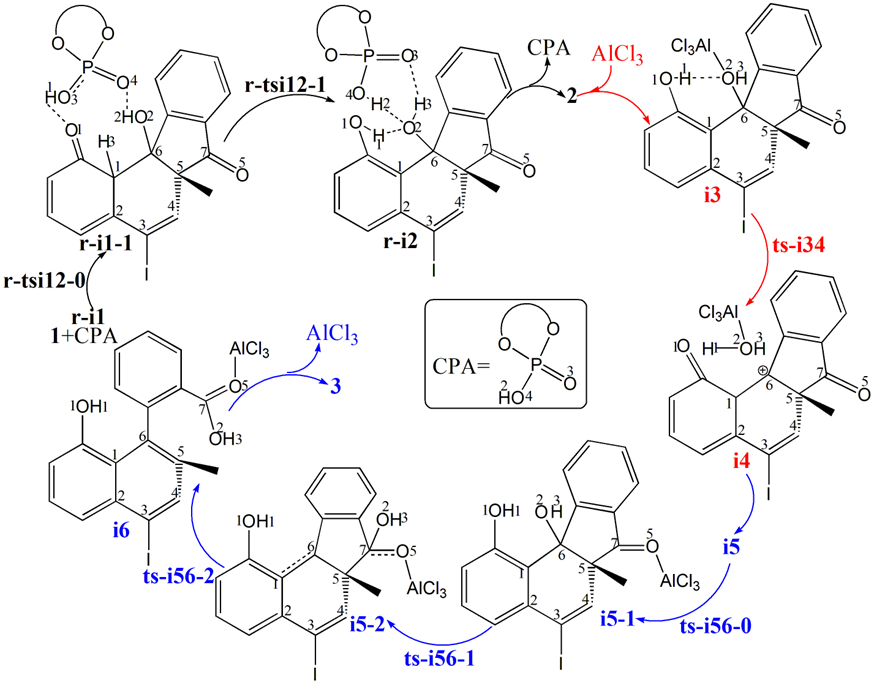
Figure 2: Proposed reaction mechanism of CPA-catalyzed intramolecular Friedel-Crafts alkylation of 1 affording 2 and AlCl3-promoted carbocation rearrangement/aromatization delivering 3. TS is named according to the two intermediates it connects.
| TS | ΔG≠gas | ΔG≠sol |
| r-tsi12-0 | 24.2 | 24.2 |
| r-tsi12-1 | 36.1 | 35.5 |
| s-tsi12-0 | 30.6 | 31.6 |
| s-tsi12-1 | 35.9 | 35.6 |
| tsi34 | 6.9 | 4.9 |
| tsi56-0 | 17.7 | 17.4 |
| tsi56-1 | 28.6 | 27.9 |
| tsi56-2 | 1.7 | 3.1 |
Table 1: The activation energy (in kcal mol−1) of all reactions in gas and solvent
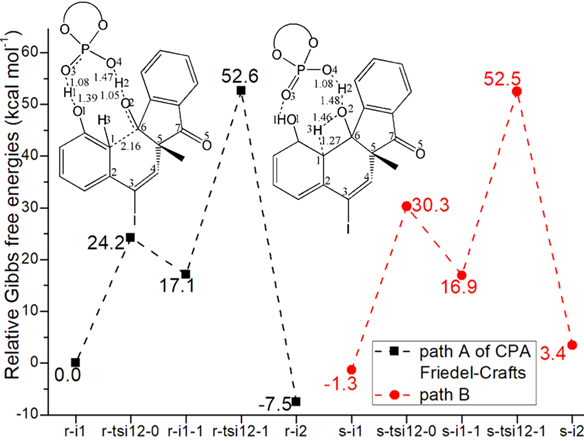
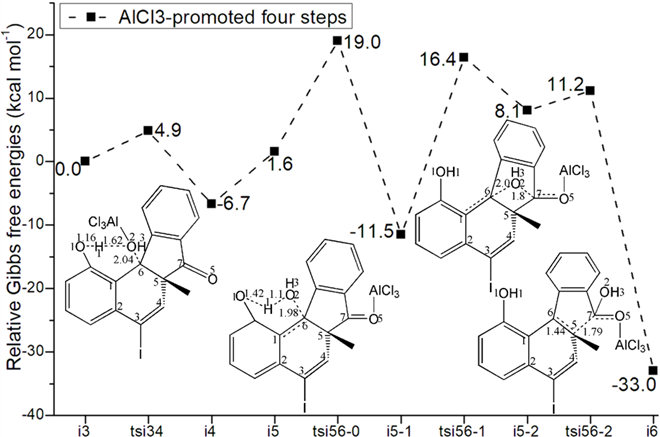
Figure 3: Relative Gibbs free energy profile in solvent phase starting from complex (a) r-i1 (b) i3 (Bond lengths of optimized TSs in Å).
3.1 CPA-catalyzed intramolecular Friedel-Crafts alkylation
Two steps are located for the first phaseof CPA-catalyzed intramolecular Friedel-Crafts alkylation. Owing to the same process, “r” stationary points from less-hindered Re-face will be discussed in detail denoted as path A (black dash line of Figure 3a). The initial complex r-i1 is stabilized by bis-coordination of CPA with carbonyl and phenol motif of 1 forming H bond depending on P-O4H2 and P=O3. The intramolecular nucleophilic addition proceeds via r-tsi12-0 in step 1 with the activation energy of 24.2 kcal mol−1 relative to the starting point r-i1 endothermic by 17.1 kcal mol−1 producing r-i1-1. The transition vector containstwo parts in concerted modes that is dual proton transfer of H1 from O1 to O3 and H2 from O4 to O2 followed by approaching of negative C1 to positive C6 (1.39, 1.08, 1.47, 1.05, 2.16 Å) (Figure S1a). Obviously with formal C1-C6 single bond, the new six-membered ring in r-i1-1 is reactive to initiate next step.
Then mediated by CPA, the proton transfer occurs via r-tsi12-1 as step 2 with activation energy of 35.5 kcal mol−1 exothermic by -7.5 kcal mol−1 giving intermediate r-i2. The transition vector includes proton H3 on sp3 hybrid C1 moving to O2 along with cooperated returing of H2 from O2 to O4 (1.27, 1.46, 1.48, 1.08 Å) (Figure S1b). In stable r-i2, O2H3 not only forms bis-coordination with CPA via two H bonds but makes inter O1-H1···O2 available. In addition, C1 recovers sp2 hybrid of phenol after kicking off H3. Clearly during two steps of thefirst phase, CPA constantly functions as LA providing H-bridge driving force. When Friedel-Crafts alkylation is completed, the central chiral tertiary alcohol 2 is obtained after removal of CPA.
3.2 AlCl3-promoted dehydration/carbocation rearrangement/carboxyl formation/aromatization
Four steps are located in next phase promoted by AlCl3, which plays role of BA acceptinglone pair of hydroxyl or carbonyl. The initial intermediate i3 is formed with Al-O2H3 coordination taken as new starting point of the four steps (black dash line of Figure 3b). Assisted by AlCl3, the dehydration undergoes in step 3 via ts-i34 with activation energy of 4.9 kcal mol−1 affording i4 exothermic by -6.7 kcal mol−1. According to the transition vector, O2H3 and H1 donated by phenol O1 assembles water molecule, which is ruptured from C6 afterwards that is remarkable O1···H1···O2 and C6···O2 cleavage (1.16, 1.62, 2.04 Å) (Figure S1c). Taken away of water by AlCl3 affords positive C6 adjacent to quaternary chiral center C5 within carbocation i4. Subsequently, the rearrangement of i4 generates reactive i5 with increased relative energy. This is achieved through dissociation of AlCl3 with water andturns to activate another carbonyl residual C7=O5 forming Al-O5 single bond. In step 4, the water molecule H1O2H3 reversely splits into hydrogen H1 and hydroxyl O2H3 to recover phenol and link to positive C6. An intermediate i5-1 is delivered via tsi56-0 with activation energy of 17.4 kcal mol−1 exothermic by -11.5 kcal mol−1 . The transition vector corresponds to O2···H1···O1 and O2···C6 linkage (1.1, 1.42, 1.98 Å) just opposite to the case of ts-i34 (Figure S1d). Although characterized by similar structure with i3, i5-1 becomes more stable with lower energy indicating this worthy transformation. Next, hydroxyl O2H3 moves from C6 to C7 via tsi56-1 instep 5 with activation energy of 27.9 kcal mol−1 endothermic by 8.1 kcal mol−1 yielding carboxyl group of i5-2. The transition vectorreveals breaking of O2···C6 and bonding of O2-C7 (2.0, 1.8 Å) (Figure S1e). i5-2 is quite reactive ready for the final step. Consequently, the opening of five-membered ring proceeds via tsi56-2 in step 6 with small activation energy of 3.1 kcal mol−1 enormously exothermic by -33.0 kcal mol−1. In resultant i6, the conjugated naphthol structure is obtainedvia aromatization that is simultaneous new C5-C6 double bond formation. The detailed atomic motion is illustrated according to the transition vector about dissociation of C5-C7 and shortening of C5-C6 bond from single to double (1.79, 1.44 Å) (Figure S1f). Once AlCl3 is left, axially chiral biaryls 3 is achieved denoting central-to-axial chirality conversion between methyl/phenol substituents and carboxylic moiety. Comparatively, proton transfer mediated by CPA of step 2 is determined to be rate-limiting for the whole process. To highlight the idea of feasibility for changes in electron density and not molecular orbital interactions are responsible of the reactivity of organic molecules, quantum chemical tool Multiwfn was applied to analyze of electron density such as MBO results of bonding atoms and contribution of atomic orbital to HOMO of typical TSs (Table S3, Figure S2). These results all confirm the above analysis.
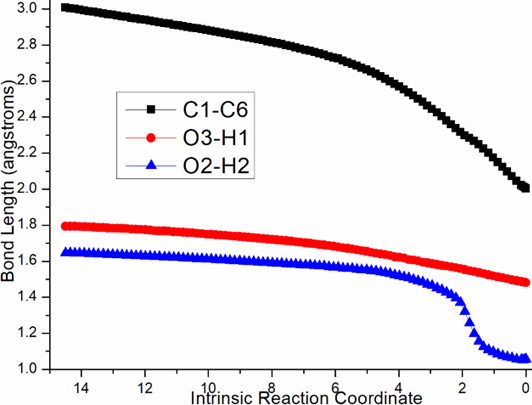
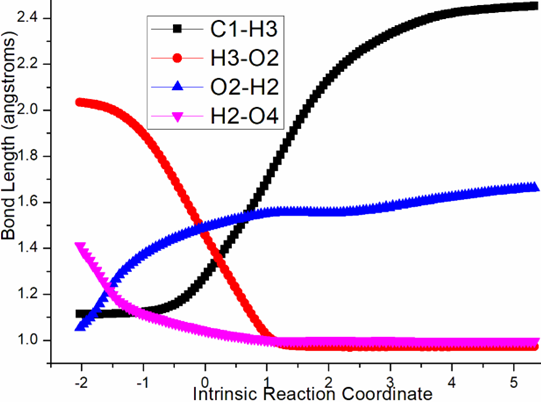
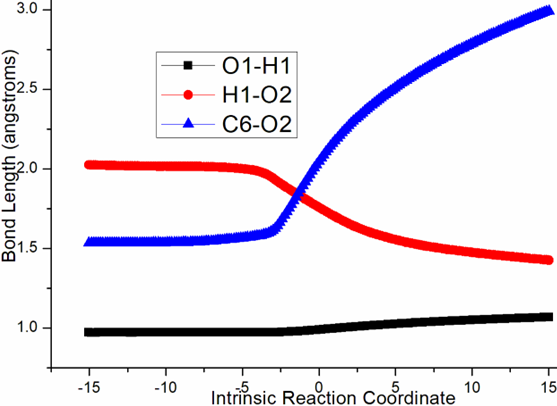
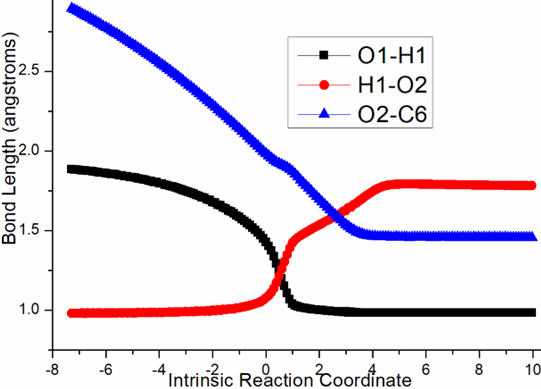
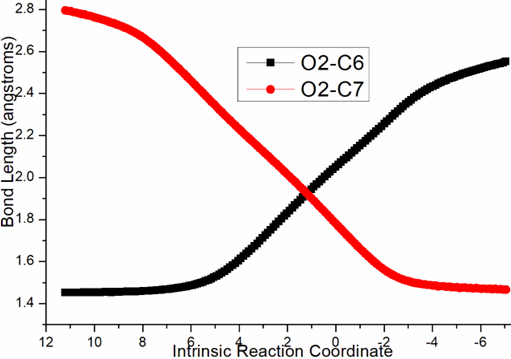
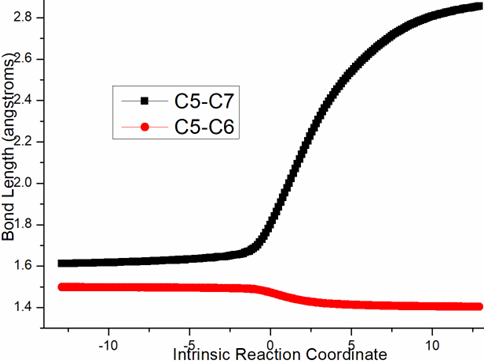
Figure S1. Evolution of bond lengths along the IRC for (a) r-tsi12-0 (b) r-tsi12-1 (c) ts-i34 (d) tsi56-0 (e) tsi56-1 (f) tsi56-2 at B3LYP/6-311++G(d,p) level.
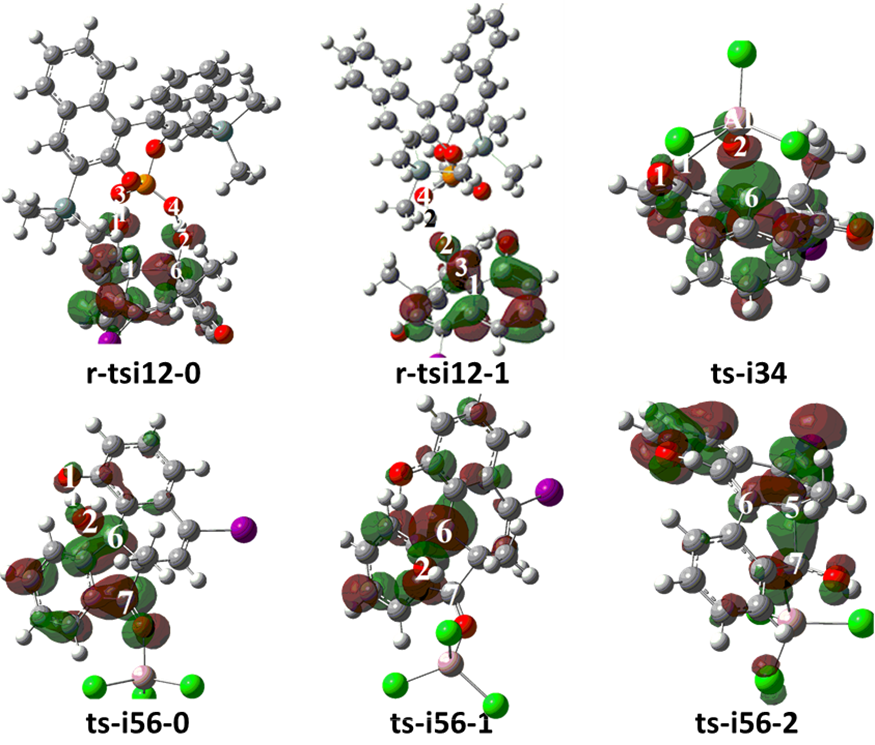
Figure S2. Highest Occupied Molecular Orbital (HOMO) of typical TSs. Different colors are used to identify the phase of the wave functions.
3.3 Desymmetrization and stereoselectivity within central chiral alcohol
To investigate the promotion of CPA, the desymmetrization and stereoselectivity within tertiary alcohol are also explored via comparison between parallel path B from more-shielded Si-face of the previous two steps (red dash line of Figure 3a). The complex between 1, 2 and BF3·OEt2 is denoted as i1. The nucleophilic addition proceeds via s-tsi12-0 in step 1 with activation energy of 31.6 kcal mol−1 relative to the starting point s-i1 endothermic by 16.9 kcal mol−1 producing s-i1-1. The proton transfer occurs via s-tsi12-1 as step 2 with activation energy of 35.6 kcal mol−1 endothermic by 3.4 kcal mol−1 giving s-i2. Evidently, the significant difference lies in barrier of path A from less-hindered Re-face lower than that of path B from more-shielded Si-face (24.2 vs 31.6 kcal mol−1). What’s more,the relative energy of Friedel-Crafts product r-i2 is also lower than that of s-i2 (-7.5 vs 3.4 kcal mol−1). Hence, the steric effect arrtibuted by bis-trimethyl silyl substituents of CPA differentiates Friedel-Crafts alkylation from less-hindered Re-face or more-shielded Si-face of carbonyl confirming the former advantageous both from kinetics and thermodynamics leading to desymmetrization and stereoselectivity within tertiary alcohol [21].
Our DFT calculations provide the first theoretical investigation on CPA-catalyzed intramolecular Friedel-Crafts alkylation of 2,2′-disubstituted 1,3-indandione. The reaction is initiated by bis-coordination of CPA with carbonyl and phenol of indandione via two steps of nucleophilic attack and proton transfer with the latter determined to be rate-limiting. The promotion of CPA not only lies in H-bridge driving force but steric effect attributed by big silyl substituents confirming less-hindered Re-face more favorable than more-shielded Si-face both from kinetics and thermodynamics leading to desymmetrization and stereoselectivity within central chiral alcohol. Next as BA accepting lone pair of hydroxyl or carbonyl, AlCl3-promoted process contains four steps. The dehydration undergoes giving positive carbocation. The rearrangement of carbocation arises from dissociation of water with AlCl3, which activates another carbonyl. The water molecule reversely splits into hydrogen and hydroxyl to recover phenol. Then hydroxyl turns from positive carbon to carbonyl carbon yielding carboxyl group. Finally the conjugated naphthol is obtained from opening of five-membered ring with concerted double bond formation. The central-to-axial chirality conversion is secured between methyl/phenol substituents and carboxylic moiety of axially chiral biaryls. The positive solvation effect is suggested by decreased absolute and activation energies in toluene solution compared with in gas. These results are supported by Multiwfn analysis on FMO composition of specific TSs, and MBO value of vital bonding, breaking.
Electronic Supplementary Material
Supplementary data available: [Computation information and cartesian coordinates of stationary points; Calculated relative energies for the ZPE-corrected Gibbs free energies (ΔGgas), and Gibbs free energies (ΔGsol) for all species in solution phase at 353 K.]
Clearly Auctoresonline and particularly Psychology and Mental Health Care Journal is dedicated to improving health care services for individuals and populations. The editorial boards' ability to efficiently recognize and share the global importance of health literacy with a variety of stakeholders. Auctoresonline publishing platform can be used to facilitate of optimal client-based services and should be added to health care professionals' repertoire of evidence-based health care resources.

Journal of Clinical Cardiology and Cardiovascular Intervention The submission and review process was adequate. However I think that the publication total value should have been enlightened in early fases. Thank you for all.

Journal of Women Health Care and Issues By the present mail, I want to say thank to you and tour colleagues for facilitating my published article. Specially thank you for the peer review process, support from the editorial office. I appreciate positively the quality of your journal.
Journal of Clinical Research and Reports I would be very delighted to submit my testimonial regarding the reviewer board and the editorial office. The reviewer board were accurate and helpful regarding any modifications for my manuscript. And the editorial office were very helpful and supportive in contacting and monitoring with any update and offering help. It was my pleasure to contribute with your promising Journal and I am looking forward for more collaboration.

We would like to thank the Journal of Thoracic Disease and Cardiothoracic Surgery because of the services they provided us for our articles. The peer-review process was done in a very excellent time manner, and the opinions of the reviewers helped us to improve our manuscript further. The editorial office had an outstanding correspondence with us and guided us in many ways. During a hard time of the pandemic that is affecting every one of us tremendously, the editorial office helped us make everything easier for publishing scientific work. Hope for a more scientific relationship with your Journal.

The peer-review process which consisted high quality queries on the paper. I did answer six reviewers’ questions and comments before the paper was accepted. The support from the editorial office is excellent.

Journal of Neuroscience and Neurological Surgery. I had the experience of publishing a research article recently. The whole process was simple from submission to publication. The reviewers made specific and valuable recommendations and corrections that improved the quality of my publication. I strongly recommend this Journal.

Dr. Katarzyna Byczkowska My testimonial covering: "The peer review process is quick and effective. The support from the editorial office is very professional and friendly. Quality of the Clinical Cardiology and Cardiovascular Interventions is scientific and publishes ground-breaking research on cardiology that is useful for other professionals in the field.

Thank you most sincerely, with regard to the support you have given in relation to the reviewing process and the processing of my article entitled "Large Cell Neuroendocrine Carcinoma of The Prostate Gland: A Review and Update" for publication in your esteemed Journal, Journal of Cancer Research and Cellular Therapeutics". The editorial team has been very supportive.

Testimony of Journal of Clinical Otorhinolaryngology: work with your Reviews has been a educational and constructive experience. The editorial office were very helpful and supportive. It was a pleasure to contribute to your Journal.

Dr. Bernard Terkimbi Utoo, I am happy to publish my scientific work in Journal of Women Health Care and Issues (JWHCI). The manuscript submission was seamless and peer review process was top notch. I was amazed that 4 reviewers worked on the manuscript which made it a highly technical, standard and excellent quality paper. I appreciate the format and consideration for the APC as well as the speed of publication. It is my pleasure to continue with this scientific relationship with the esteem JWHCI.

This is an acknowledgment for peer reviewers, editorial board of Journal of Clinical Research and Reports. They show a lot of consideration for us as publishers for our research article “Evaluation of the different factors associated with side effects of COVID-19 vaccination on medical students, Mutah university, Al-Karak, Jordan”, in a very professional and easy way. This journal is one of outstanding medical journal.
Dear Hao Jiang, to Journal of Nutrition and Food Processing We greatly appreciate the efficient, professional and rapid processing of our paper by your team. If there is anything else we should do, please do not hesitate to let us know. On behalf of my co-authors, we would like to express our great appreciation to editor and reviewers.

As an author who has recently published in the journal "Brain and Neurological Disorders". I am delighted to provide a testimonial on the peer review process, editorial office support, and the overall quality of the journal. The peer review process at Brain and Neurological Disorders is rigorous and meticulous, ensuring that only high-quality, evidence-based research is published. The reviewers are experts in their fields, and their comments and suggestions were constructive and helped improve the quality of my manuscript. The review process was timely and efficient, with clear communication from the editorial office at each stage. The support from the editorial office was exceptional throughout the entire process. The editorial staff was responsive, professional, and always willing to help. They provided valuable guidance on formatting, structure, and ethical considerations, making the submission process seamless. Moreover, they kept me informed about the status of my manuscript and provided timely updates, which made the process less stressful. The journal Brain and Neurological Disorders is of the highest quality, with a strong focus on publishing cutting-edge research in the field of neurology. The articles published in this journal are well-researched, rigorously peer-reviewed, and written by experts in the field. The journal maintains high standards, ensuring that readers are provided with the most up-to-date and reliable information on brain and neurological disorders. In conclusion, I had a wonderful experience publishing in Brain and Neurological Disorders. The peer review process was thorough, the editorial office provided exceptional support, and the journal's quality is second to none. I would highly recommend this journal to any researcher working in the field of neurology and brain disorders.

Dear Agrippa Hilda, Journal of Neuroscience and Neurological Surgery, Editorial Coordinator, I trust this message finds you well. I want to extend my appreciation for considering my article for publication in your esteemed journal. I am pleased to provide a testimonial regarding the peer review process and the support received from your editorial office. The peer review process for my paper was carried out in a highly professional and thorough manner. The feedback and comments provided by the authors were constructive and very useful in improving the quality of the manuscript. This rigorous assessment process undoubtedly contributes to the high standards maintained by your journal.

International Journal of Clinical Case Reports and Reviews. I strongly recommend to consider submitting your work to this high-quality journal. The support and availability of the Editorial staff is outstanding and the review process was both efficient and rigorous.

Thank you very much for publishing my Research Article titled “Comparing Treatment Outcome Of Allergic Rhinitis Patients After Using Fluticasone Nasal Spray And Nasal Douching" in the Journal of Clinical Otorhinolaryngology. As Medical Professionals we are immensely benefited from study of various informative Articles and Papers published in this high quality Journal. I look forward to enriching my knowledge by regular study of the Journal and contribute my future work in the field of ENT through the Journal for use by the medical fraternity. The support from the Editorial office was excellent and very prompt. I also welcome the comments received from the readers of my Research Article.

Dear Erica Kelsey, Editorial Coordinator of Cancer Research and Cellular Therapeutics Our team is very satisfied with the processing of our paper by your journal. That was fast, efficient, rigorous, but without unnecessary complications. We appreciated the very short time between the submission of the paper and its publication on line on your site.

I am very glad to say that the peer review process is very successful and fast and support from the Editorial Office. Therefore, I would like to continue our scientific relationship for a long time. And I especially thank you for your kindly attention towards my article. Have a good day!

"We recently published an article entitled “Influence of beta-Cyclodextrins upon the Degradation of Carbofuran Derivatives under Alkaline Conditions" in the Journal of “Pesticides and Biofertilizers” to show that the cyclodextrins protect the carbamates increasing their half-life time in the presence of basic conditions This will be very helpful to understand carbofuran behaviour in the analytical, agro-environmental and food areas. We greatly appreciated the interaction with the editor and the editorial team; we were particularly well accompanied during the course of the revision process, since all various steps towards publication were short and without delay".

I would like to express my gratitude towards you process of article review and submission. I found this to be very fair and expedient. Your follow up has been excellent. I have many publications in national and international journal and your process has been one of the best so far. Keep up the great work.

We are grateful for this opportunity to provide a glowing recommendation to the Journal of Psychiatry and Psychotherapy. We found that the editorial team were very supportive, helpful, kept us abreast of timelines and over all very professional in nature. The peer review process was rigorous, efficient and constructive that really enhanced our article submission. The experience with this journal remains one of our best ever and we look forward to providing future submissions in the near future.

I am very pleased to serve as EBM of the journal, I hope many years of my experience in stem cells can help the journal from one way or another. As we know, stem cells hold great potential for regenerative medicine, which are mostly used to promote the repair response of diseased, dysfunctional or injured tissue using stem cells or their derivatives. I think Stem Cell Research and Therapeutics International is a great platform to publish and share the understanding towards the biology and translational or clinical application of stem cells.

I would like to give my testimony in the support I have got by the peer review process and to support the editorial office where they were of asset to support young author like me to be encouraged to publish their work in your respected journal and globalize and share knowledge across the globe. I really give my great gratitude to your journal and the peer review including the editorial office.

I am delighted to publish our manuscript entitled "A Perspective on Cocaine Induced Stroke - Its Mechanisms and Management" in the Journal of Neuroscience and Neurological Surgery. The peer review process, support from the editorial office, and quality of the journal are excellent. The manuscripts published are of high quality and of excellent scientific value. I recommend this journal very much to colleagues.

Dr.Tania Muñoz, My experience as researcher and author of a review article in The Journal Clinical Cardiology and Interventions has been very enriching and stimulating. The editorial team is excellent, performs its work with absolute responsibility and delivery. They are proactive, dynamic and receptive to all proposals. Supporting at all times the vast universe of authors who choose them as an option for publication. The team of review specialists, members of the editorial board, are brilliant professionals, with remarkable performance in medical research and scientific methodology. Together they form a frontline team that consolidates the JCCI as a magnificent option for the publication and review of high-level medical articles and broad collective interest. I am honored to be able to share my review article and open to receive all your comments.

“The peer review process of JPMHC is quick and effective. Authors are benefited by good and professional reviewers with huge experience in the field of psychology and mental health. The support from the editorial office is very professional. People to contact to are friendly and happy to help and assist any query authors might have. Quality of the Journal is scientific and publishes ground-breaking research on mental health that is useful for other professionals in the field”.

Dear editorial department: On behalf of our team, I hereby certify the reliability and superiority of the International Journal of Clinical Case Reports and Reviews in the peer review process, editorial support, and journal quality. Firstly, the peer review process of the International Journal of Clinical Case Reports and Reviews is rigorous, fair, transparent, fast, and of high quality. The editorial department invites experts from relevant fields as anonymous reviewers to review all submitted manuscripts. These experts have rich academic backgrounds and experience, and can accurately evaluate the academic quality, originality, and suitability of manuscripts. The editorial department is committed to ensuring the rigor of the peer review process, while also making every effort to ensure a fast review cycle to meet the needs of authors and the academic community. Secondly, the editorial team of the International Journal of Clinical Case Reports and Reviews is composed of a group of senior scholars and professionals with rich experience and professional knowledge in related fields. The editorial department is committed to assisting authors in improving their manuscripts, ensuring their academic accuracy, clarity, and completeness. Editors actively collaborate with authors, providing useful suggestions and feedback to promote the improvement and development of the manuscript. We believe that the support of the editorial department is one of the key factors in ensuring the quality of the journal. Finally, the International Journal of Clinical Case Reports and Reviews is renowned for its high- quality articles and strict academic standards. The editorial department is committed to publishing innovative and academically valuable research results to promote the development and progress of related fields. The International Journal of Clinical Case Reports and Reviews is reasonably priced and ensures excellent service and quality ratio, allowing authors to obtain high-level academic publishing opportunities in an affordable manner. I hereby solemnly declare that the International Journal of Clinical Case Reports and Reviews has a high level of credibility and superiority in terms of peer review process, editorial support, reasonable fees, and journal quality. Sincerely, Rui Tao.

Clinical Cardiology and Cardiovascular Interventions I testity the covering of the peer review process, support from the editorial office, and quality of the journal.

Clinical Cardiology and Cardiovascular Interventions, we deeply appreciate the interest shown in our work and its publication. It has been a true pleasure to collaborate with you. The peer review process, as well as the support provided by the editorial office, have been exceptional, and the quality of the journal is very high, which was a determining factor in our decision to publish with you.
The peer reviewers process is quick and effective, the supports from editorial office is excellent, the quality of journal is high. I would like to collabroate with Internatioanl journal of Clinical Case Reports and Reviews journal clinically in the future time.

Clinical Cardiology and Cardiovascular Interventions, I would like to express my sincerest gratitude for the trust placed in our team for the publication in your journal. It has been a true pleasure to collaborate with you on this project. I am pleased to inform you that both the peer review process and the attention from the editorial coordination have been excellent. Your team has worked with dedication and professionalism to ensure that your publication meets the highest standards of quality. We are confident that this collaboration will result in mutual success, and we are eager to see the fruits of this shared effort.

Dear Dr. Jessica Magne, Editorial Coordinator 0f Clinical Cardiology and Cardiovascular Interventions, I hope this message finds you well. I want to express my utmost gratitude for your excellent work and for the dedication and speed in the publication process of my article titled "Navigating Innovation: Qualitative Insights on Using Technology for Health Education in Acute Coronary Syndrome Patients." I am very satisfied with the peer review process, the support from the editorial office, and the quality of the journal. I hope we can maintain our scientific relationship in the long term.
Dear Monica Gissare, - Editorial Coordinator of Nutrition and Food Processing. ¨My testimony with you is truly professional, with a positive response regarding the follow-up of the article and its review, you took into account my qualities and the importance of the topic¨.

Dear Dr. Jessica Magne, Editorial Coordinator 0f Clinical Cardiology and Cardiovascular Interventions, The review process for the article “The Handling of Anti-aggregants and Anticoagulants in the Oncologic Heart Patient Submitted to Surgery” was extremely rigorous and detailed. From the initial submission to the final acceptance, the editorial team at the “Journal of Clinical Cardiology and Cardiovascular Interventions” demonstrated a high level of professionalism and dedication. The reviewers provided constructive and detailed feedback, which was essential for improving the quality of our work. Communication was always clear and efficient, ensuring that all our questions were promptly addressed. The quality of the “Journal of Clinical Cardiology and Cardiovascular Interventions” is undeniable. It is a peer-reviewed, open-access publication dedicated exclusively to disseminating high-quality research in the field of clinical cardiology and cardiovascular interventions. The journal's impact factor is currently under evaluation, and it is indexed in reputable databases, which further reinforces its credibility and relevance in the scientific field. I highly recommend this journal to researchers looking for a reputable platform to publish their studies.

Dear Editorial Coordinator of the Journal of Nutrition and Food Processing! "I would like to thank the Journal of Nutrition and Food Processing for including and publishing my article. The peer review process was very quick, movement and precise. The Editorial Board has done an extremely conscientious job with much help, valuable comments and advices. I find the journal very valuable from a professional point of view, thank you very much for allowing me to be part of it and I would like to participate in the future!”

Dealing with The Journal of Neurology and Neurological Surgery was very smooth and comprehensive. The office staff took time to address my needs and the response from editors and the office was prompt and fair. I certainly hope to publish with this journal again.Their professionalism is apparent and more than satisfactory. Susan Weiner

My Testimonial Covering as fellowing: Lin-Show Chin. The peer reviewers process is quick and effective, the supports from editorial office is excellent, the quality of journal is high. I would like to collabroate with Internatioanl journal of Clinical Case Reports and Reviews.

My experience publishing in Psychology and Mental Health Care was exceptional. The peer review process was rigorous and constructive, with reviewers providing valuable insights that helped enhance the quality of our work. The editorial team was highly supportive and responsive, making the submission process smooth and efficient. The journal's commitment to high standards and academic rigor makes it a respected platform for quality research. I am grateful for the opportunity to publish in such a reputable journal.
My experience publishing in International Journal of Clinical Case Reports and Reviews was exceptional. I Come forth to Provide a Testimonial Covering the Peer Review Process and the editorial office for the Professional and Impartial Evaluation of the Manuscript.

I would like to offer my testimony in the support. I have received through the peer review process and support the editorial office where they are to support young authors like me, encourage them to publish their work in your esteemed journals, and globalize and share knowledge globally. I really appreciate your journal, peer review, and editorial office.
Dear Agrippa Hilda- Editorial Coordinator of Journal of Neuroscience and Neurological Surgery, "The peer review process was very quick and of high quality, which can also be seen in the articles in the journal. The collaboration with the editorial office was very good."

I would like to express my sincere gratitude for the support and efficiency provided by the editorial office throughout the publication process of my article, “Delayed Vulvar Metastases from Rectal Carcinoma: A Case Report.” I greatly appreciate the assistance and guidance I received from your team, which made the entire process smooth and efficient. The peer review process was thorough and constructive, contributing to the overall quality of the final article. I am very grateful for the high level of professionalism and commitment shown by the editorial staff, and I look forward to maintaining a long-term collaboration with the International Journal of Clinical Case Reports and Reviews.
To Dear Erin Aust, I would like to express my heartfelt appreciation for the opportunity to have my work published in this esteemed journal. The entire publication process was smooth and well-organized, and I am extremely satisfied with the final result. The Editorial Team demonstrated the utmost professionalism, providing prompt and insightful feedback throughout the review process. Their clear communication and constructive suggestions were invaluable in enhancing my manuscript, and their meticulous attention to detail and dedication to quality are truly commendable. Additionally, the support from the Editorial Office was exceptional. From the initial submission to the final publication, I was guided through every step of the process with great care and professionalism. The team's responsiveness and assistance made the entire experience both easy and stress-free. I am also deeply impressed by the quality and reputation of the journal. It is an honor to have my research featured in such a respected publication, and I am confident that it will make a meaningful contribution to the field.

"I am grateful for the opportunity of contributing to [International Journal of Clinical Case Reports and Reviews] and for the rigorous review process that enhances the quality of research published in your esteemed journal. I sincerely appreciate the time and effort of your team who have dedicatedly helped me in improvising changes and modifying my manuscript. The insightful comments and constructive feedback provided have been invaluable in refining and strengthening my work".

I thank the ‘Journal of Clinical Research and Reports’ for accepting this article for publication. This is a rigorously peer reviewed journal which is on all major global scientific data bases. I note the review process was prompt, thorough and professionally critical. It gave us an insight into a number of important scientific/statistical issues. The review prompted us to review the relevant literature again and look at the limitations of the study. The peer reviewers were open, clear in the instructions and the editorial team was very prompt in their communication. This journal certainly publishes quality research articles. I would recommend the journal for any future publications.

Dear Jessica Magne, with gratitude for the joint work. Fast process of receiving and processing the submitted scientific materials in “Clinical Cardiology and Cardiovascular Interventions”. High level of competence of the editors with clear and correct recommendations and ideas for enriching the article.

We found the peer review process quick and positive in its input. The support from the editorial officer has been very agile, always with the intention of improving the article and taking into account our subsequent corrections.

My article, titled 'No Way Out of the Smartphone Epidemic Without Considering the Insights of Brain Research,' has been republished in the International Journal of Clinical Case Reports and Reviews. The review process was seamless and professional, with the editors being both friendly and supportive. I am deeply grateful for their efforts.
To Dear Erin Aust – Editorial Coordinator of Journal of General Medicine and Clinical Practice! I declare that I am absolutely satisfied with your work carried out with great competence in following the manuscript during the various stages from its receipt, during the revision process to the final acceptance for publication. Thank Prof. Elvira Farina

Dear Jessica, and the super professional team of the ‘Clinical Cardiology and Cardiovascular Interventions’ I am sincerely grateful to the coordinated work of the journal team for the no problem with the submission of my manuscript: “Cardiometabolic Disorders in A Pregnant Woman with Severe Preeclampsia on the Background of Morbid Obesity (Case Report).” The review process by 5 experts was fast, and the comments were professional, which made it more specific and academic, and the process of publication and presentation of the article was excellent. I recommend that my colleagues publish articles in this journal, and I am interested in further scientific cooperation. Sincerely and best wishes, Dr. Oleg Golyanovskiy.

Dear Ashley Rosa, Editorial Coordinator of the journal - Psychology and Mental Health Care. " The process of obtaining publication of my article in the Psychology and Mental Health Journal was positive in all areas. The peer review process resulted in a number of valuable comments, the editorial process was collaborative and timely, and the quality of this journal has been quickly noticed, resulting in alternative journals contacting me to publish with them." Warm regards, Susan Anne Smith, PhD. Australian Breastfeeding Association.

Dear Jessica Magne, Editorial Coordinator, Clinical Cardiology and Cardiovascular Interventions, Auctores Publishing LLC. I appreciate the journal (JCCI) editorial office support, the entire team leads were always ready to help, not only on technical front but also on thorough process. Also, I should thank dear reviewers’ attention to detail and creative approach to teach me and bring new insights by their comments. Surely, more discussions and introduction of other hemodynamic devices would provide better prevention and management of shock states. Your efforts and dedication in presenting educational materials in this journal are commendable. Best wishes from, Farahnaz Fallahian.
Dear Maria Emerson, Editorial Coordinator, International Journal of Clinical Case Reports and Reviews, Auctores Publishing LLC. I am delighted to have published our manuscript, "Acute Colonic Pseudo-Obstruction (ACPO): A rare but serious complication following caesarean section." I want to thank the editorial team, especially Maria Emerson, for their prompt review of the manuscript, quick responses to queries, and overall support. Yours sincerely Dr. Victor Olagundoye.

Dear Ashley Rosa, Editorial Coordinator, International Journal of Clinical Case Reports and Reviews. Many thanks for publishing this manuscript after I lost confidence the editors were most helpful, more than other journals Best wishes from, Susan Anne Smith, PhD. Australian Breastfeeding Association.

Dear Agrippa Hilda, Editorial Coordinator, Journal of Neuroscience and Neurological Surgery. The entire process including article submission, review, revision, and publication was extremely easy. The journal editor was prompt and helpful, and the reviewers contributed to the quality of the paper. Thank you so much! Eric Nussbaum, MD
Dr Hala Al Shaikh This is to acknowledge that the peer review process for the article ’ A Novel Gnrh1 Gene Mutation in Four Omani Male Siblings, Presentation and Management ’ sent to the International Journal of Clinical Case Reports and Reviews was quick and smooth. The editorial office was prompt with easy communication.

Dear Erin Aust, Editorial Coordinator, Journal of General Medicine and Clinical Practice. We are pleased to share our experience with the “Journal of General Medicine and Clinical Practice”, following the successful publication of our article. The peer review process was thorough and constructive, helping to improve the clarity and quality of the manuscript. We are especially thankful to Ms. Erin Aust, the Editorial Coordinator, for her prompt communication and continuous support throughout the process. Her professionalism ensured a smooth and efficient publication experience. The journal upholds high editorial standards, and we highly recommend it to fellow researchers seeking a credible platform for their work. Best wishes By, Dr. Rakhi Mishra.

Dear Jessica Magne, Editorial Coordinator, Clinical Cardiology and Cardiovascular Interventions, Auctores Publishing LLC. The peer review process of the journal of Clinical Cardiology and Cardiovascular Interventions was excellent and fast, as was the support of the editorial office and the quality of the journal. Kind regards Walter F. Riesen Prof. Dr. Dr. h.c. Walter F. Riesen.

Dear Ashley Rosa, Editorial Coordinator, International Journal of Clinical Case Reports and Reviews, Auctores Publishing LLC. Thank you for publishing our article, Exploring Clozapine's Efficacy in Managing Aggression: A Multiple Single-Case Study in Forensic Psychiatry in the international journal of clinical case reports and reviews. We found the peer review process very professional and efficient. The comments were constructive, and the whole process was efficient. On behalf of the co-authors, I would like to thank you for publishing this article. With regards, Dr. Jelle R. Lettinga.

Dear Clarissa Eric, Editorial Coordinator, Journal of Clinical Case Reports and Studies, I would like to express my deep admiration for the exceptional professionalism demonstrated by your journal. I am thoroughly impressed by the speed of the editorial process, the substantive and insightful reviews, and the meticulous preparation of the manuscript for publication. Additionally, I greatly appreciate the courteous and immediate responses from your editorial office to all my inquiries. Best Regards, Dariusz Ziora

Dear Chrystine Mejia, Editorial Coordinator, Journal of Neurodegeneration and Neurorehabilitation, Auctores Publishing LLC, We would like to thank the editorial team for the smooth and high-quality communication leading up to the publication of our article in the Journal of Neurodegeneration and Neurorehabilitation. The reviewers have extensive knowledge in the field, and their relevant questions helped to add value to our publication. Kind regards, Dr. Ravi Shrivastava.

Dear Clarissa Eric, Editorial Coordinator, Journal of Clinical Case Reports and Studies, Auctores Publishing LLC, USA Office: +1-(302)-520-2644. I would like to express my sincere appreciation for the efficient and professional handling of my case report by the ‘Journal of Clinical Case Reports and Studies’. The peer review process was not only fast but also highly constructive—the reviewers’ comments were clear, relevant, and greatly helped me improve the quality and clarity of my manuscript. I also received excellent support from the editorial office throughout the process. Communication was smooth and timely, and I felt well guided at every stage, from submission to publication. The overall quality and rigor of the journal are truly commendable. I am pleased to have published my work with Journal of Clinical Case Reports and Studies, and I look forward to future opportunities for collaboration. Sincerely, Aline Tollet, UCLouvain.

Dear Ms. Mayra Duenas, Editorial Coordinator, International Journal of Clinical Case Reports and Reviews. “The International Journal of Clinical Case Reports and Reviews represented the “ideal house” to share with the research community a first experience with the use of the Simeox device for speech rehabilitation. High scientific reputation and attractive website communication were first determinants for the selection of this Journal, and the following submission process exceeded expectations: fast but highly professional peer review, great support by the editorial office, elegant graphic layout. Exactly what a dynamic research team - also composed by allied professionals - needs!" From, Chiara Beccaluva, PT - Italy.

Dear Maria Emerson, Editorial Coordinator, we have deeply appreciated the professionalism demonstrated by the International Journal of Clinical Case Reports and Reviews. The reviewers have extensive knowledge of our field and have been very efficient and fast in supporting the process. I am really looking forward to further collaboration. Thanks. Best regards, Dr. Claudio Ligresti
Dear Chrystine Mejia, Editorial Coordinator, Journal of Neurodegeneration and Neurorehabilitation. “The peer review process was efficient and constructive, and the editorial office provided excellent communication and support throughout. The journal ensures scientific rigor and high editorial standards, while also offering a smooth and timely publication process. We sincerely appreciate the work of the editorial team in facilitating the dissemination of innovative approaches such as the Bonori Method.” Best regards, Dr. Giselle Pentón-Rol.
